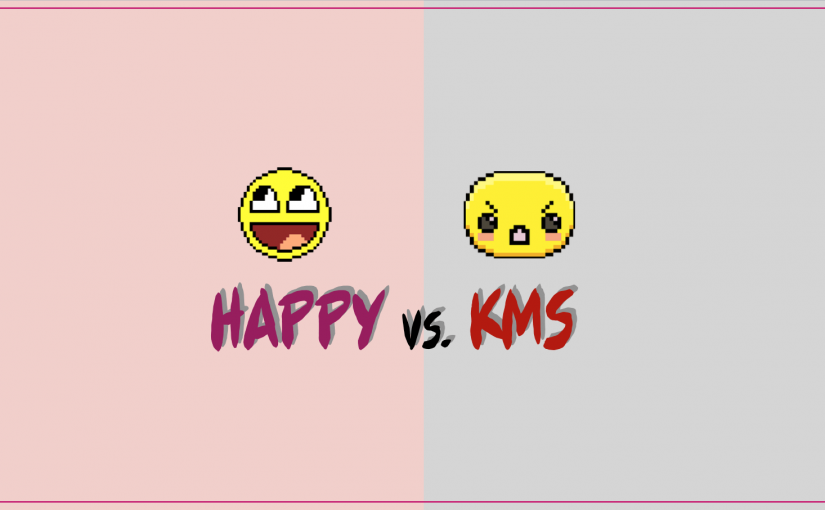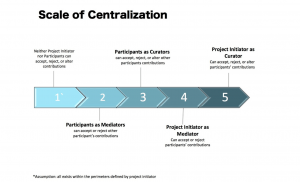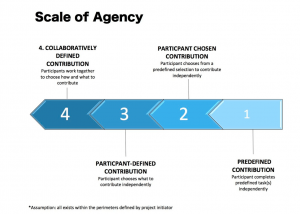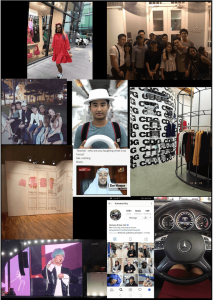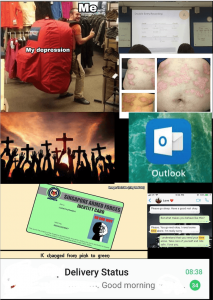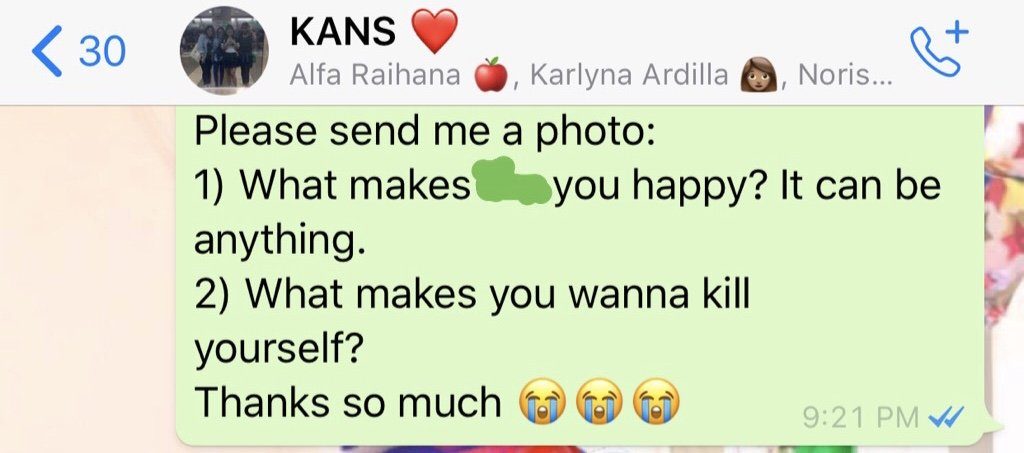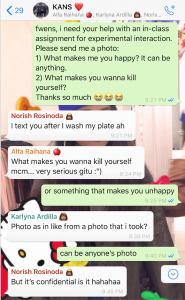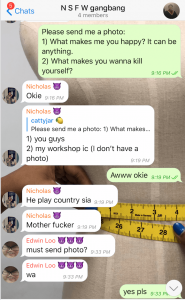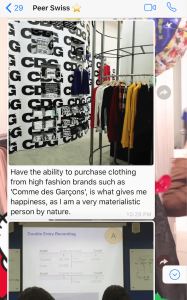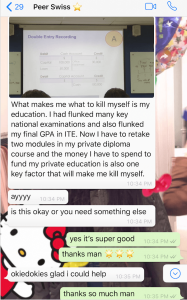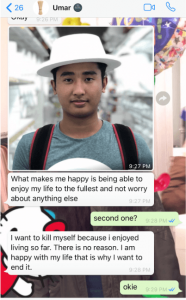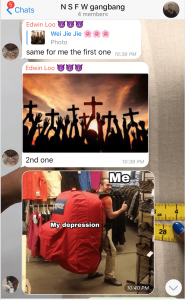Crowd-sourced art is about a collaborative process which focus on inclusivity of the artist and outsourcing its formation to willing participants using networked communication to create an artwork. The artist creates an intent and the starting point with setting a task and a series of instructions, followed by the participants’ contribution and approach to the project which will be the final product of the artwork. It revolves around the concept of (DIWO: Do-It-With-Others) which was taught in the previous class.
An interesting research regarding crowd-sourced art which shows the scale of how much control the creator of the project are willing to allow the participants to take control in creating the final outcome of the artwork. Source: https://amt-lab.org/blog/2018/7/crowdsourced-digital-art-projects-centralization-and-agency
My team members are Alicia Ng and Brian Chong.
HAPPY vs. KMS
Our crowd-sourced community was targeted at our contact list on WhatsApp messenger, an instant messaging platform that allows electronic devices to exchange text, image, video, audio messages and location of the users. We decided to choose WhatsApp because it allows our participants to have different ways to respond and we can approach our participants in a group chat or a personal chat setting.
This collective artwork garners contribution from our willing participants on WhatsApp to provide a photo response to the respective questions;
“What makes you happy? It can be anything.”
“What makes you wanna kill yourself?”
The objective of our artwork is to gather an image representation of what makes them happy or what makes them wanna kill themselves without any text. The goal intended is to create a collage of the two notion of happiness and sadness with the contribution of the participants thus, showcasing the final two collage to the audience who will be viewing and guessing the overall sentiment of each collage. Hence, the social interaction involves the creators’ intent, participant’s response and the audience’s opinion about the artwork.
First layer of interaction between the creators and the participants is sending out the task and instructions for them to respond to. Second layer of interaction is the participants have a choice to respond and participate or just ignore.
RESPONSE
The participants had questions and different interpretation of the instructions given so they had to clarify what must they do in order to respond to my question. All these questioning made us realised a few ways to improve and make our instructions clearer for majority of the audience to understand easily.
DIFFERENT RESPONSES IN DIFFERENT SETTINGS
We realised there were different response and reaction when the instructions were being sent out to the individual personally and in a group chat setting.
Personal Chat
The attitude of the participants who were being approached in a personal chat tend to be more expressive and put in a lot of thought before answering the questions. It wasn’t necessary to explain the meaning behind those photos they’ve sent but they were genuine about expressing their thoughts.
The responses received from a group setting tend to be a bit more humorous and silly. It takes just the one person to set the tone of the conversation to be serious or humorous. In addition, being in a group chat, your response tend to be build upon the previous reply thus, influencing conformity.
FINAL OUTCOME
The final collage of the two notions of happiness and sadness were presented to our class, creating a third layer of interaction. Without any text and just images collected from our participants, we made the audience guess the overall sentiment of the collage. Despite the participants not being physically there, their contribution added value and completed the project with the intent that we had as our end goal. We as creators, were curious too about the final outcome of the collage as the participant’s contribution is unpredictable which spark our sense of curiousity and engagement.
Personally, I felt it was a success because the audience were able to relate to the sentiments of the photos in the collage. Despite not putting restrictions to our participant’s contribution of their representation of these emotions, the audience managed to interpret the notions of happiness and sadness.
OBSERVATION & TAKEAWAYS
- There were different responses despite setting a task and instructions given which is just a photo to answer the questions asked. However, due to different interpretation of the participants of the task at hand, despite disrupting the overall approach of the concept, it gives a creative outlook of the crowdsourced artwork, making it more unique with a sense of depth. Personally, I just think it’s human nature to rebel against the task given to stand out more or being able to feel a sense of control unconsciously in whatever we partake in.
- To my surprise, majority of the participants did not ask the purpose behind those questions and answered without questioning due to the factors such as the closeness of our relationship and trust. However, some were curious about their involvement and wanting to see the overall outcome of the crowd-sourced project. Some of the participants were particular about their privacy and anonymity, hence, wanting us to crop out some of the details.
- We expected the interaction to stop after most of the participants made contribution to the project, however, it enables a conversation in the group chat to be active again, discussing about our well-being at the moment and wanting to meet up. Hence, it shows that certain conversation can be built upon our previous responses and interaction. “It just takes one person to start a movement.”
- “People have different persona in all spaces”. The responses might differ according to the setting of the environment hence, affecting the authenticity of the contribution which leads back to the intent of the creators.
How is your crowd-sourced project different from one that is created by a single artist/creator?
Our crowd-sourced project starts off with an intent and approach to the whole concept which is versatile. We tried not give a lot of restrictions so the participants have the freedom to express themselves. Our end goal is unpredictable and changes every time we receive a response from the participants, so there was no definite outcome to the whole artwork. Every contribution adds value to the whole collage hence, it is dynamic process of a doing crowd-sourced art. Majority of the control of the direction and outcome of the artwork is depended on the participants which is determined by the layout and perimeters are formed by the creators on the platform.
A single artist/creator usually have an end goal to the whole process but not necessarily. However, the process of doing the artwork won’t be so dynamic as there isn’t a crowd to control the direction of the artwork freely. Hence, the process of the artwork is not as ever-changing and the end goal is most likely predictable since the creator have the upper hand of the overall work.
Inspiration for our crowd-sourced artwork: Sketch Aquarium
Art Science Museum – Sketch Aquarium
The Art Science Museum created an interactive augmented reality platform which is an aquarium where visitors are allowed to create their own version of animals by drawing from their imagination that can be scanned and transform from 2D piece into a movable 3D piece which will be placed into this AR platform. The objective is to ignite the visitor’s creative spark and create a collage of all the unique contribution of the visitors into this AR ecosystem that is enhanced with subtle background music and LED lights projected onto a screen. Each artwork is unique individually and all of the contribution of the visitors creates a beautiful ecosystem with a variety of species and colours.
Hence, giving the participants the freedom to contribute to the outcome of the artwork can be unpredictable and dynamic as an end goal. However, it’s one of the unique yet challenging feature of doing a crowd-sourced artwork as a creator or project initiator.

